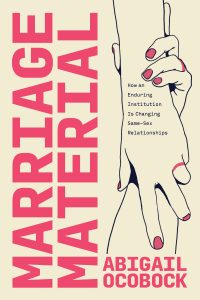Abigail Ocobock is a sociologist of families, sexualities, and gender. She has been researching and writing about marriage for over a decade. Her work has appeared in journals like The American Journal of Sociology and The Journal of Marriage and Family as well as in publications such as The Atlantic, Bustle, Slate, and The Daily Beast. Her 2024 book, Marriage Material: How an Enduring Institution is Changing Same-Sex Relationships, published by The University of Chicago Press, draws on interview data with over 100 LGBQ+ individuals, who were among the first to gain access to legal same-sex marriage. She examines how marriage is changing same-sex relationships, and how same-sex couples are changing marriage. You can find out more about Abigail at her website. And you can follow her on Bluesky @abiocobock.bsky.social
AMW: How do LGBTQ+ people challenge heteronormative assumptions about marriage?

AO: That depends. What types of marriage behaviors are you imagining? Which kinds of LGBTQ+ people are you thinking of? Do you want to know how they try to, or only how they succeed?
LGBTQ+ people regularly resist marital practices that center on assumptions of gender inequality and sexual ownership. Widely shared beliefs emanating from the LGBTQ+ community concerning gender equality and sexual freedom provide them with alternative scripts for behavior.
Engagement proposals stand out as an example. Older LGBTQ+ people who had sustained long-term relationships prior to legal access to marriage usually rejected the need for a proposal, seeing them as a heteronormative practice unnecessary for their relationships. Younger LGBTQ+ people in newer same-sex relationships tended to be much more heteronormative. They insisted on proposals for signaling commitment and as the epitome of romance. Yet they also often insisted on equality in proposal practices. They argued that in heterosexual relationships a man proposing symbolizes his ownership and control of the woman. They made conscious efforts to ensure both partners were mutually proposed to instead. But escaping heteronormativity is not always so easy, and same-sex couples unconsciously bought into heteronormative ideas even while consciously rejecting others. Heterosexual men’s proposals also symbolize his readiness to commit based on gendered ideas about men’s weaker commitment. Some LGBTQ+ people subscribed to a gender-neutral version of this idea, arguing that the person who most needed to demonstrate commitment should be propose first.
Another area in which LGBTQ+ people challenged heteronormativity was marital nonmonogamy. Many sustained non-monogamous marriages. Moreover, many “currently monogamous” individuals displayed a remarkable openness to nonmonogamy as a future relationship form. They believed that spouses should attend to changing sexual desires and needs, and prioritize relational commitment over fidelity. More accurately defined as sexually fluid than monogamous, they were consciously questioning the marital monogamy norm. However, the security they felt to explore nonmonogamy emanated in part from a heteronormative belief that marriage represents a unique form of relational commitment, that outside sex could therefore less easily undermine. In these ways, and others, we observe a messy mix of both heteronormative and LGBTQ+ cultural beliefs and practices in same-sex marriage.
AMW: How does marriage change the dynamics of same-sex relationships?
AO: To be clear, marriage already influenced the dynamics of same-sex relationships before it became legal to marry. Many same-sex couples drew on marital meanings and rituals in their relationships, for example by exchanging rings and having commitment ceremonies, even though they never expected the institution to legally include them.
But after same-sex marriage became legal we observe a much more transformative impact. Half the LGBTQ+ people who participated in my study had formed relationships prior to the availability of legal marriage, half only afterward. The stark contrast between their relationships makes the impact of marital access clear. Younger LGBTQ+ individuals who had come of age with access to legal marriage enacted their relationships very differently than older LGBTQ+ individuals who had sustained relationships without it. For the younger cohort, marriage was taken-for- granted, widely conceived as the norm, and required for relationship investment and success. New dates were vetted as potential marriage material. Reassurances about marriage were needed to feel secure. And marriage was a regular source of tension and conflict in their relationships. This was not usually true for the older cohort, who were better able to conceptualize love and commitment outside of a marital model.
Access to marriage has brought many gains for same-sex couples, including providing a clearer model for long-term relationship planning, the enjoyment of participating in widely recognized cultural practices for relationships, and a way to gain social validation and legitimacy. These freedoms serve to make same-sex relationships more easily legible between partners and to others. But same-sex relationships have also lost something important—the freedom from marriage. Having access to legal marriage has limited what LGBTQ+ people are able to imagine. It shapes how they evaluate potential partners and then narrowly defines commitment and security, creating qualitatively new forms of work, anxiety, and conflict.
AMW: Why does marriage persist even though family life has changed so much?
AO: Americans might be waiting longer to marry, cohabiting first, and having children outside of marriage, but most young Americans still want and expect to marry. Looking at marriage from an institutional perspective, my research shows that marriage persists because it remains a powerful institution with the ability to shape our choices. It operates through three broad institutional mechanisms – regulative, normative, and cultural-cognitive – which work independently and in tandem.
The regulative part of marriage operates through formal rules and laws, such as the policies of state and federal governments, which provide married couples access to rights denied to the nonmarried. So long as marriage maintains a monopoly over important rights and protections the institution will persist. I saw this power among LGBTQ+ people who did not want to marry and who critiqued marriage as an institution, but who nonetheless ultimately decided to marry, or expected to do so in the future, for no other reason than to gain access to some benefit, such as health insurance.
The normative part of marriage helps it persist through informal norms, expectations, and values. People continue to marry because they feel a sense of duty or social pressure to do so, or because they have internalized expectations that marrying is the right thing to do. Many younger LGBTQ+ people believed marrying before having children was the “right thing to do,” despite having only vague understandings of why. Some LGBTQ+ people who did not want to marry also found themselves succumbing to social pressure to marry their more enthusiastic partners, because their own political rejection of marriage was made to feel “selfish” or “immature” in comparison to their partner’s more socially approved of desire for marriage
Lastly, the cultural-cognitive part of the institution ensures marriage persists by establishing shared ideas about what has meaning and shaping what people are able to imagine for themselves. Individuals often marry simply because they cannot conceive of alternatives as meaningful ways to live. Despite the recency of access to legal marriage, many younger LGBTQ+ people took for granted that marriage represents a unique form of relational commitment like. As such, they simply could not imagine long-term relationships without it. So long as our culture promotes this idea, marriage will persist – even if the regulative and normative based mechanisms driving marriage weaken.
Alicia M. Walker is Associate Professor of Sociology at Missouri State University and the author of two previous books on infidelity, and a forthcoming book, Bound by BDSM: What Practitioners can teach Everyone about Building a Happier Life (Bloomsbury Fall 2025) coauthored with Arielle Kuperberg. She is the current Editor in Chief of the Council of Contemporary Families blog, serves as Senior Fellow with CCF, and serves as Co-Chair of CCF alongside Arielle Kuperberg. Learn more about her on her website. Follow her on Twitter or Bluesky at @AliciaMWalker1, Facebook, and Instagram @aliciamwalkerphd


Comments